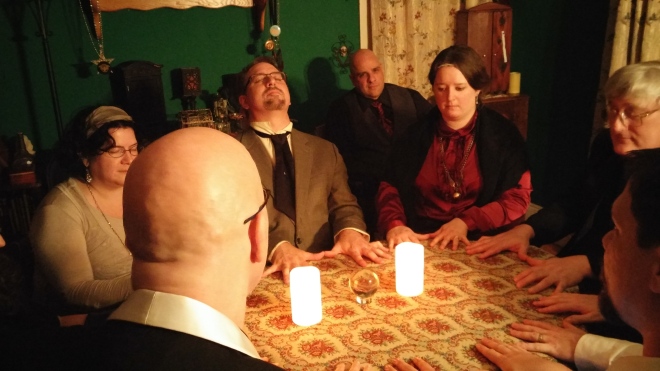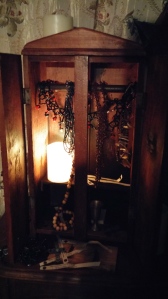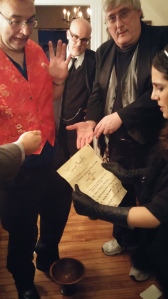****THIS POST CONTAINS SPOILERS FOR MY GAME****
March came and went. Night at Miskatonic University ran our 4th game: The Arctic Expedition and it didn’t quite go as we had planned. Later I plan on posting the game for use, after I make it digestible by humans. I also want to fix what I perceived to be major problems in the game during run time.
Background:
The Arctic Expedition is a LARP inspired by H.P. Lovecraft, and other works of frozen horror. The game’s run time is 4-6 hours for 15 players, it heavily relies on props and immersive moments. The rules use our own home-brew system called Stix, which has many self marshaling mechanics, and a very high risk (deadly) combat system. The game’s setting is in the northern arctic circle. Where the PCs are trapped at their base camp, fending off the frozen wastes and starvation.
Game Opener:
Year 1952 a Scientific Expedition deep into the Arctic Circle, has set up a small base camp to further study the biological ecosystems of the Arctic and find any Anthropological or Geographical findings of note. The Expedition is a combined effort between the United States Navy, and a privately funded group of Academic Explorers from Miskatonic University. The Navy is accompanying scientists as part of a National program.
The field team, composed of Miskatonic Scientists and Navy Specialists, has found remains from what they suspect to be an ancient organism, fossilized deep in the icy mountains. The remains of the specimen, frozen in a chunk of ice, is currently undergoing observations from the lab research team. The team, consisting of both field and lab researchers have been stationed out in the cold wastes of the Arctic for over two months.
Unfortunately due to a sudden storm, the field researchers have not yet returned from their week long hike up the slopes of mount Erebus to retrieve the last of the fossils being examined. The team’s Survival Specialist was recently injured from the first trip into the mountains and was unable to escort the field team for the second journey. Instead his/her son was used as a guide. It has now been over a week since the field team should have arrived back. The storms outside have increases in intensity. Emotions are running high as the two teams attempt to organize themselves and coordinate a plan, with what limited rations and supplies they have. Yet as the team starts to put the pieces together something more sinister waits for them in the ice.
The Driving Force
This game focuses on isolation, starvation, loneliness, and cold. Naturally there are Wendigo. The main conflicts in the game are the PCs succumbing to their loneliness, hunger and the cold, which transforms them into the monster Wendigo. The Wendigo have goals of their own, mainly promoting starvation in others, and attempting to fill their own void by eating those around them. PCs that do not fall to the Wendigo are trying to uncover a strange formation of ice just out side their camp. These PCs have several challenges involving science and later the occult that would later benefit them, or at least give them a chance to escape. There is also a sub-plot involving Communism, and the fate of your Naval ship off the coast. The sub-plot becomes a secondary concern once people start disappearing.
Everyone is encouraged to show up hungry. Food is then brought out to feed the PCs as soon as dead bodies start showing up in the game. We had 2-3 NPC roles to fulfill early on death counts but it ended up not being needed.
In the best case ending, a few PCs remain to send a broadcast to a new Naval ship who sends a rescue plane. Those PCs then would have to make a distraction for the Wendigo PCs, and make a break for it towards the plane.
Worst case scenario everyone dies before anyone even has a chance at knowing what is going on.
The Good:
- Players enjoyed themselves.
- The high tension moments went off without a hitch.
- Starvation mechanic was well received.
- Hands on challenges such as the radio construction, were a huge success.
- There were a lot of different challenges, no one was ever bored.
- The effects were awesome.
- Donations paid for the game.
- The jello heart and organ molds were delicious.
The first portion of the game went as expected; the radio broadcasts were great, the PCs went out to find their missing party members. The ribs were ready to eat by the time there were some dead bodies around. The game starts with all the PCs at the base having just figured out that their missing field team isn’t going to be returning to the base. While out investigating we (being the runners of the game) set off a large bonfire that is the PC’s food supply. The PCs come back to a giant fire and the realization that they will starve out here. Then the radio is sabotaged. After that point a lot of the pacing and plot of the game is put into the players’ hands.
The Bad:
- There were many miscommunications from when stages start and what happens in each, to creature effects.
- Stages were clunky and didn’t really add anything to the game.
- PvP was far too deadly and caused the game to end 2 hours earlier than anticipated.
- I was the only rules arbitrator which caused game breaking holds.
- The game set up split up the action to a point where I could not observe the entire game.
- I had no way to communicate over long distances.
- We were low on additional helping hands.
- It was the hottest day in March; there was no snow.
The game was set in our home, on an acre of land. I divided my home up from the basement, to the living room, to the outside. This caused me to run back and forth across my yard, and up and down my stairs several time to just observe what was going on. There were two players who had become Wendigo about an hour into the game (this is far too early). They had a lot of discussions and worked together to pick off the other players; I being only one person found it difficult to follow their movements while also monitoring the several other challenges I put into the game. This caused a lot of issues around what the PCs found to be important at what time vs what I, the game runner, found to be important to the over all conflict. For example, the science experiments were very important to the PCS, however I needed to marshal the killing spree caused by the monsters in the other room, that the PC scientists had no idea about.
To top it all off, there was no snow. Which was a major blow for several reasons that might not be too apparent:
- We had a few gallons of fake blood to use for deaths. This would have left trails and tracks in the snow for survival based PCs. Boots could also be tracked.
- We had to remove all digging/snow search challenges.
- It was 60 degrees out that day; if it had snowed people wouldn’t have wanted to wade out into the wilds of our backyard as much as they did.
- Snow would have slowed movement down, making it harder to run away, walk away and move in general around the outdoors.
Fun fact, it snowed the next weekend, 6 inches.
The Improvements:
- I need to either reduce the number of PCs or get another rules person and story person, to help me run the game. Currently we have 1 rules person, and 1 effects person.
- We need to readdress our combat system if we are going to continue with any PvP combat. Currently it is too easy/quick to kill a person.
- Removing a call out of the stage changes to the game and halting game when they happen.
- The creature showed up way too soon in the story, it shouldn’t show up till stage two.
- Encourage future games to have the base camp all in one game, instead of splitting up the game space.
- Don’t rely too heavily on the natural elements of mother nature.
Overall, the game went well. Most players didn’t notice the behind the curtain panic. I as a Story Teller would say that out of the group of other games I’ve run this was the weakest on the part of the game runners. The Seance was much more controlled and even that had some bumps. We tried too many new things with this games. We added the concept of stages, we flipped to a PvP model instead of a 80% PvE model with 20% PvP conflict, we did a different type of room layout, and we added a few new types of challenges. Really we should have focused on one new mechanic/gameplay type.
Glad we learned from this experience and we look forward to our next game ( A Lovecraftian game set in the age of Pirates) Black Waters!


